 I began gaming through RPGs and I’m sure, like many, I started with Dungeons and Dragons (DnD). Over the years, I have played tons of RPG game systems, but two are my all-time favorites: DnD and Call of Cthulhu (CoC). In 2014 WOTC released DnD 5th Edition and most fans, including myself, came back to fold after jumping ship to Pathfinder or were finally able to get over the bad taste of 4th Edition. 5e made many fans, including me, love DnD again.
I began gaming through RPGs and I’m sure, like many, I started with Dungeons and Dragons (DnD). Over the years, I have played tons of RPG game systems, but two are my all-time favorites: DnD and Call of Cthulhu (CoC). In 2014 WOTC released DnD 5th Edition and most fans, including myself, came back to fold after jumping ship to Pathfinder or were finally able to get over the bad taste of 4th Edition. 5e made many fans, including me, love DnD again.
Fast-forward to the Fall of 2018, Petersen Games launched a Kickstarter for Sandy Petersen’s Cthulhu Mythos for 5e (SPCM). I hope you were like me and thrilled that SPCM was coming for two reasons. First, if you don’t know Sandy Petersen, he was the original designer of the Call of Cthulhu RPG. If you’ve ever read or played any his Mythos based games, it’s obvious to see his passion and knowledge of this topic is unrivaled. The second is that many fans (especially me) have been waiting a long time for this melding of these two RPG worlds. Yes, there was the 2016 SPCM Pathfinder version, which I’m sure was excellent, but the 5e version is the one that incorporates my two all-time favorite RPGs and is the focus of today’s review.
This will not be a normal tabletop review because it will not have a Gameplay Overview since SPCM is a rules compendium for 5e. Overall, SPCM is part of Dungeon Master’s Guide, Player’s Handbook, and Monster Manual for how to incorporate the Mythos universe into your 5e campaign. Instead, I’ll highlight what’s included (trying not to give away too many spoilers), what I like, and my final thoughts on the overall SPCM book.
Intro to Mythos & Horror
Chapter 1 focuses on some basics for DMs to learn and absorb for their campaigns. The first part of the chapter, as expected, does an excellent job defining the Mythos for those unfamiliar with it. The second part of the chapter gives a deeper dive by giving great tips and specific advice for how best to twist horror and Mythos elements into heroic fantasy adventures and their worlds. Overall, you get some great ideas and solid examples for how to blend horror into existing or new campaigns. Please note: don’t skip this chapter because if you’ve never played or ran a horror campaign, there is important information to absorb.
Mythos Races and Character Options
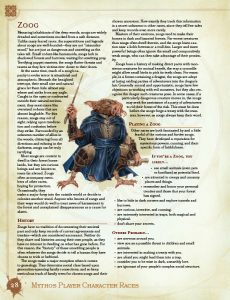
Chapters 2 & 3 focus on character development of new Mythos races and new character class options. Chapter 2 opens with adding 4 new Mythos races: Dreamland Cat, Ghouls, Gnorri, and Zoogs and each is provided with detailed information of their history, physical appearance, society, faith, lifespan, etc. which far exceeds the information of the base races in the PHB. I must admit, I would never have thought to use some of these starting player races, but after reading each, they’re all interesting, with some rather surprising like Ghouls which are not undead but living undead eaters. The last section of Chapter 2 focuses on two otherworldly humanlike races: Leng Folk and Tcho-Tcho. Both races tend toward the chaotic evil due to their oppressive or murderous cultures, but any good DM or player can find a way to incorporate any race into their heroic campaign (ever hear of the Drow named Drizzt?).
SPCM Chapter 3 opens with some logical recommendations for what the 4 Mythos races would tend toward classwise, but what I like the best is that there are new Mythos options for each of the base character classes from the PHB. This is a great way to incorporate the Mythos into any character class. This chapter also includes a new Wisdom-based skill: Yog-Sothothery which is essentially the classic CoC skill: Cthulhu Mythos. This skill measures character’s Mythos lore and any new understandings of Mythos phenomenon. Like that classic CoC skill- the mind weakens as more Mythos knowledge is gained and so characters with this skill will take a penalty equal to half their skill against Dread Difficulty Checks (DC). The chapter ends with new Mythos related backgrounds and even new feats for mostly Mythos races and base PHB classes.
Dread and Insanity
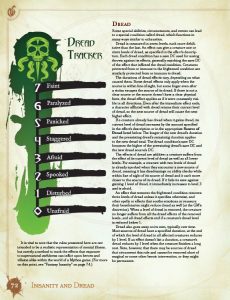
If you’ve ever played any version of CoC, the loss of sanity is a huge part of the game as characters learn of and are exposed to the Mythos. Thankfully, Chapter 4 of SPCM brings two concepts to 5e that mimic this loss: Dread and Insanity. Dread, for the most part, will have minor effects on a character and is treated like exhaustion. Dread is measured by 7 levels, with each level having its own DC used for saving throws against its effect.
Insanity, on the other hand, will have long-term effects and functions similarly to disease. Unlike Dread, there are not levels, but instead, there is Insanity Strength that characters must make DC saves against or gain an Insanity type determined by the DM (or randomly). Lastly, there are three varying degrees of Insanity to determine just how insane your character is or has become. Honestly, I know it sounds like I might be losing my mind, but I was happy to see Dread and Insanity included in SPCM. This is a much-needed and key element of Mythos gaming which generally creates great roleplaying opportunities for DM and players alike.
The last part of Chapter 4 outlines Aklo, the occult language, and its outer worldly roots. SPCM goes a step further and ties this dark language to traditional DnD monsters and races. The chapter ends with an explanation and how to enter the Dreamlands, which is like planar travel. Yes, these both seem like odd placements in a chapter focused primarily on Dread and Insanity, but Aklo and Dreamlands are key elements that need attention and explanation, so I guess it needed to go somewhere.
Spellcasting and Mythos Items & Texts
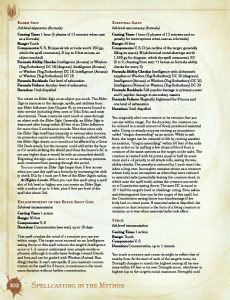
Chapter 5 of the SPCM brings us to Spellcasting in the Mythos. This form of magic relies on the use of highly specialized Formulas that are usually beyond mortal understanding. These Formula spells are found in forbidden tombs or in the thoughts of sinister outsiders. What is both surprising and frightening about Formula magic is that any character willing to learn can cast these spells without a Spell List class feature, but there’s a price (insert sinister laugh). The price is two-fold – characters will make Formula ability checks and whether they have success or not in casting, the character will suffer Backlash that results in physical or mental harm. The second is Failure; if the Formula spell is not successfully cast, then additional effects will further debilitate the character. SPCM does add these Formula spells to existing spell-casting characters spells lists, so it’s great to see that players will have the option to gain them during creation or advancement. If you’re familiar with CoC spells then there will not be too many new surprises but welcomed ones nonetheless.
We now get to my favorites in Chapter 6, the Mythos items and texts. First are the mundane adventuring items and then it moves to the Mythos magic items and Alien technology. Most of the Mythos magic items and Alien tech are wondrous and artifact items with availability ranging from uncommon to legendary. There are also texts of the Mythos. Researching texts is a long process and as usual with the Mythos, not without a price. If a character fails, they automatically gain Dread and even if they succeed, they still must make a save against gaining Dread since the research itself will likely be disturbing.
Mythos Cults, Great Old Ones, & Outer Gods
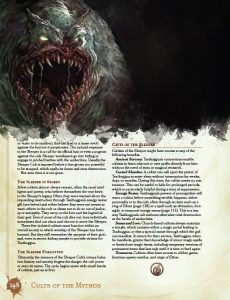
I doubt that you’ll be shocked to know that the cults of the Mythos generally worship a specific Great Old One or Outer God. Chapter 7 of SPCM begins by focusing on the “Big 8” of the Mythos Cults and the “Gifts” that their followers may receive from worshipping them. The text leading up each cult’s “Gifts” gives an excellent description of its organizational structure and practices, as well as who or what typically makes up its membership. The chapter goes onto to various minor cults with similar information as the “Big 8”. The chapter ends with a detailed overview of Tcho-Tcho and Deep Ones cultures and how they are tied to their cults.
Chapter 8 opens with detailed explanations of what the Outer Gods and Great Old Ones are and how they’re related or not. The chapter continues with Great Old Ones, Old Ones, Outer Gods, Ancient Ones, and stat blocks, but SPCM defines this information as Elder Influences or manifestations instead of being thought of as monsters. These beings can be defeated if specific conditions are fulfilled, but never destroyed. Each stat block lists the following for each Elder Influence: its primary source, favored weapon, symbol, temple, worshippers, and servitors then followed by similar stats that appear in the Monster Manual. I was glad to see that SPCM continues the philosophy that these terrible beings can be stopped (usually at great cost), but not destroyed and that they will rise again when called.
Mythos Monsters
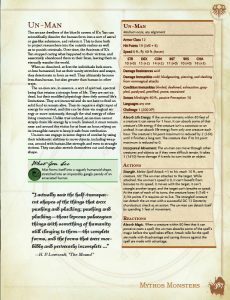
The final chapter of the SPCM focuses on the Mythos Monsters and starts with some great plot hook short and long-term examples for how to possibly incorporate them into your campaign. Much like Monster Manual – the SPCM provides stat blocks but adds more detailed descriptions about each monster. One detail that I love that is included in with each Mythos Monster (and this also appears in Chapter 8) are “What You See” blocks. These provide frightening detailed physical descriptions that the DM can read or adapt to give a vivid account when a character or party are first presented with a Mythos Monster, Great Old One, Outer God, etc…
Again, if you’ve played CoC or know the Mythos, then there will be many familiar monsters and some new ones associated with the Ancients. Now, this is not in Chapter 8 or 9, but relates to the Mythos Gods and Monsters. This was a big complaint that the Monster Manual didn’t do but in the SPCM extras each Mythos Monster, Great Old One, Outer God is categorized by challenge rating. Any DM should greatly appreciate how the SPCM clearly organized this information instead of having to hunt and peck as most of us did when the Monster Manual first came out.
Final Thoughts
I’m sure most readers wouldn’t be surprised if I said I love Sandy Petersen’s Cthulhu Mythos for 5e. First, by its depth and quality of the content, but also by how well it’s organized. I said in my introduction that Sandy Petersen’s Cthulhu Mythos is a 5e compendium, but it’s more than just a collection of Mythos information. What is truly the success of the SPCM for me is that it intertwines into the base 5e game rules and character classes. The SPCM takes great effort not to have its own rules that stand apart from 5e, but rather adds new elements such as Dread & Insanity, which are vital and well executed to give DnD players that Call of Cthulhu experience.
After reading and re-reading the Sandy Petersen’s Cthulhu Mythos for 5e, my only one complaint is that there is apparent artwork in a few places that does not fit a fantasy theme (i.e. formless spawn on page 320). Honestly, if you’re a DM or player looking to incorporate the Cthulhu Mythos in 5e, you probably will not care because you’ve waited so long to get your hands on a great resource like this.
Final Score: 5 Stars – The ultimate Cthulhu Mythos resource for 5e that will appeal DMs and players who are looking to add this universe into their current or new DnD campaign.
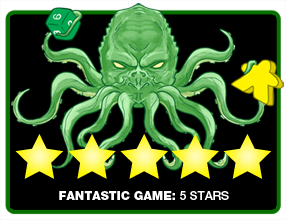 Hits:
Hits:
• Highly detailed Mythos information
• Well-organized
• Dread and Insanity for 5e
• Incorporates well into the 5e rules
Misses:
• Some artwork does not fit the fantasy theme
Disclosure: An employee for Petersen Games also writes for Board Game Quest. He had no influence over the opinions expressed in this review.






















